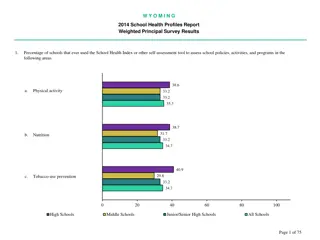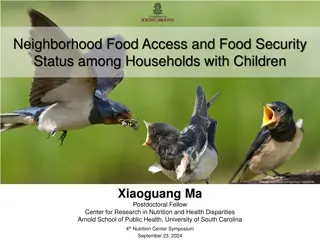Associations Between Wyoming Third Grade Body Mass Index and School Food Environment
Senate File 93 in Wyoming authorized the state's first Oral Health Initiative in 2009, focusing on measuring Body Mass Index (BMI) of third graders. The study aims to evaluate how individual and school factors influence the likelihood of children being overweight or obese. It hypothesizes that schools with policies promoting healthy eating and restricting unhealthy foods will have lower rates of overweight and obesity among students. The background discusses the definitions of overweight and obesity, national and state prevalence rates, health issues associated with childhood obesity, and factors influencing weight status.
Download Presentation

Please find below an Image/Link to download the presentation.
The content on the website is provided AS IS for your information and personal use only. It may not be sold, licensed, or shared on other websites without obtaining consent from the author.If you encounter any issues during the download, it is possible that the publisher has removed the file from their server.
You are allowed to download the files provided on this website for personal or commercial use, subject to the condition that they are used lawfully. All files are the property of their respective owners.
The content on the website is provided AS IS for your information and personal use only. It may not be sold, licensed, or shared on other websites without obtaining consent from the author.
E N D
Presentation Transcript
ASSOCIATIONS BETWEEN WYOMING THIRD GRADE BODY MASS INDEX AND THE SCHOOL FOOD ENVIRONMENT Marilyn Hammond
Introduction Senate File 93 Authorized 2009 Wyoming s first Oral Health Initiative Body Mass Index (BMI) measurements taken on a subset of 3rdgraders Current Study Goal: Evaluate the potential effects of individual and school factors on being overweight or obese Hypothesis: Children in schools with policies and practices encouraging healthy eating and limiting unhealthy foods would have a reduced odds of being overweight or obese than schools without these practices
Background Overweight and obesity are conditions defined as having excess body fat BMI, calculated from an individual s height in relation to weight, does not measure body fat, but is highly correlated with direct measures of body fat Child and adolescent BMI is age and sex specific Weight Status Category Percentile Range Underweight Less than the 5th percentile 5th percentile to less than the 85th percentile Normal weight 85th to less than the 95th percentile Overweight Equal to or greater than the 95th percentile Obese
Background Nationally, 32% of children ages 10 to 17 are overweight and 16% are obese In Wyoming, 26% of children ages 10 to 17 are overweight and 10% are obese Prevalence of Overweight and Obese Children Ages 10-17 Years in the U.S., NSCH 2007 Source: National Survey of Children s Health, 2007
Background Childhood Obesity increases: Cardiovascular and pulmonary issues Hepatic, renal, musculoskeletal, orthopedic and neurological problems Early maturation and menstrual irregularities Development, learning, behavioral and emotional problems Discrimination, stigma, shame, low self-esteem Risk of becoming an obese adult
Factors that Influence Becoming Overweight or Obese Children becoming overweight and obese is the result of a positive energy imbalance: too many calories are consumed and too few are expended Genetic Metabolic Environmental Dietary Behavioral Cultural Socioeconomic
School Food Environment Children expend 50% of their daily energy and obtain 33%- 58% of their daily energy at school The School Food Environment consists of: School Food Policies United State Department of Agriculture (USDA) National School Lunch and Breakfast Programs School wellness program Department of Defense s Fresh Fruit and Vegetable Program (DOD FFVP) Recess before lunch Competitive Foods Pouring Rights Contracts USDA s Fresh Fruit and Vegetable Program (USDA FFVP)
Data Collection 2009-2010 Oral Health Survey Height Weight Age Gender School Food Environment Characteristics were collected from: Wyoming Department of Education USDA Foods Distribution Program U.S. Census Bureau Wyoming School Nurses School District Business Directors School District Food Service Directors School Menus
Methods Study Aims Evaluate the associations between overweight and obesity among 3rd grade students and the school characteristics in this study Develop multiple logistic regression models to describe the relationship of overweight and obesity with school characteristics in this study along with adjustment for confounding variables Compare the associations found for overweight to the associations found for obesity Study Design Ecological cross-sectional survey using a subset of participants in the 2009-2010 Wyoming Oral Health Survey
Outcome Variables Outcome Groups Overweight Obese Reference Group Underweight and normal weight
School Food Environment Domain 1. Policy or practices of the district or school Variable Has a nutrition or health advisory council Information available on the nutrient content of USDA-reimbursable meals Has nutrition education in every grade No pouring rights contract Uses DOD s Fresh Fruit and Vegetable Program Uses USDA S Fresh Fruit and Vegetable Program Has nutrient requirements as part of its food purchasing specifications Recess is before lunch No school store, snack bar, a la carte at the cafeteria, continuous school fundraising activities or teachers activities selling energy-dense nutrient poor-foods 2. Availability of competitive foods and beverages No vending machines containing energy-dense nutrient-poor foods available to 3rd graders Fresh fruit or raw vegetables offered daily 3. Content of USDA lunches offered Fried potatoes not offered Dessert not offered Average meal has less than or equal to 30% calories from fat Average meal has less than or equal to 10% calories from saturated fat
Other Variables Age Gender Region - East vs. Central/West Urban or rural school location School percent of students eligible for free or reduced lunch low (below 50%) vs. high (above 50%) School percent of students in a minority racial or ethnic group low (below 34%) vs. high (above 34%) School enrollment size
Results Participation 42 out of 55 (76.4%) schools participated 1570 children out of 2012 (78%) of children in the 42 participating schools participated Study Population Gender 816 (52%) were male and 754 (48%) were female Age 5 (<1%) were 7 years of age 1173 (75%) were 8 years of age 385 (25%) were 9 years of age 8 (<1%) were 10 years of age
Total, Male and Female Numbers of Children by BMI Category Number of Male Children (Percentage of Males) Number of Female Children (Percentage of Females) Number of Children (Percentage of Total) Weight Category Underweight 37 (2.4%) 12 (1.5%) 25 (3.3%) Normal Weight 1041 (66.3%) 523 (64.1%) 518 (68.7%) Overweight 248 (15.8%) 137 (16.8%) 111 (14.7%) Obese 244 (15.5%) 144 (17.7%) 100 (13.3%)
Descriptive Statistics: Average School Prevalence of Overweight and Obese Children Standard Deviation Prevalence Mean Minimum Median Maximum Overweight Children Obese Children 31.7% 12.5% 6.5% 31.6% 74.1% 16.2% 9% 2.5% 13.8% 44.4%
Main Effects: Policy or Practices of the District or School Percent of Schools Number of Schools Domain Variable Has a nutrition or health advisory council 23 54.8% Information available on the nutrient content of USDA- reimbursable meals 39 92.9% Has nutrition education in every grade 33 78.6% Policy or practices of the district or school No pouring rights contract 31 73.8% Uses DOD s Fresh Fruit and Vegetable Program 31 73.8% Uses USDA s Fresh Fruit and Vegetable Program 20 47.6% Has nutrient requirements as part of its food purchasing specifications 16 38.1% Recess is before lunch 18 42.9%
Main Effects: Availability of Competitive Foods and Beverages Percent of Schools Number of Schools Domain Variable No school store, snack bar, a la carte at the cafeteria, continuous school fundraising activities or teachers activities selling energy-dense nutrient-poor foods 36 85.7% Availability of competitive foods and beverages No vending machines containing energy-dense nutrient- poor foods available to 3rd graders 41 97.6%
Main Effects: Content of USDA Lunches Offered Number of Schools Percent of Schools Domain Variable Fresh fruit or raw vegetables offered daily 27 64.3% Fried potatoes not offered 36 85.7% Content of USDA lunches offered Dessert not offered 18 42.9% Average meal has less than or equal to 30% calories from fat Average meal has less than or equal to 10% calories from saturated fat 37 88.1% 29 69.1%
Descriptive Statistics: Other Variables Variable Mean Standard Deviation Minimum Median Maximum Percent minority 22.9% 19.0% 3.0% 17.4% 99.0% Percent eligible for free or reduced lunch 44.1% 18.4% 7.2% 44.1% 100.0% School Enrollment 293 92 108 307 460
School Environment: Urban and Rural Categories Urban Large Rural Small Rural Isolated 15 12 8 7 35.7% 28.6% 19.1% 16.7%
Factors Influencing Being Overweight in this Study Using the DOD s FFVP decreased the odds of students being overweight by 22% (OR: 0.78, 90% CI: 0.56, 1.08) Offering fresh fruit or raw vegetables daily decreased the odds of students being overweight by 26% (OR: 0.74, 90% CI: 0.54, 1.00)
Factors Influencing Being Obese in this Study Using the USDA s FFVP decreased the odds of students being obese by 32% (OR: 0.68, 90% CI: 0.46, 1.00) Offering fresh fruit or raw vegetables daily decreased the odds of students being obese by 32% (OR: 0.68, 90% CI: 0.44, 1.00)
Discussion Limitations Cross sectional Ecological Small sample size Strengths High participation Agreement between overweight and obese models Results applicable at an ecological level Conclusions These study results show that schools that make fresh fruits and vegetables available to children may reduce the odds of them being overweight or obese























